During the lesson, the information for you to know is written in regular type, and what we suggest speaking or reading aloud to children is in bold. All resources for this lesson, including the Teacher Guide, Student Page, Family Connection Card, and other resources can be downloaded in a ZIP file by clicking on the following link:
In some lessons you will find "resource articles." These are articles written by experts from around the world to help equip you for your work with children and adolescents. Share them with parents or guardians if you consider it appropriate.
Before class, print out the Listening game pictures. Then cut or tear apart each picture.
After three days they found him in the temple courtyard. He was sitting with the teachers. He was listening to them and asking them questions.
Luke 2:46
Bible passage tells us what Jesus was like as a young boy. Even Jesus listened to others. How do you show others you are listening to them? Perhaps you look at the person speaking. Maybe you nod your head as you follow along with what the person says. However you show that you are listening, it is important to take the time to truly hear what others say to you.
There are many places in Scripture that direct you to be still, to know God, to listen at His feet, or to listen to those who give you wise advice. How difficult do you find it to actually listen to someone without thinking ahead to your response? Perhaps you are too busy, too distracted, or too proud to listen to someone. If you struggle with any of these things, confess them to the Lord. Ask Him to help you learn to pay attention to those speaking with you and truly listen!
Encourage families to listen to their children. Remind parents that their children will probably follow the examples of listening behaviour they see at home. Listening can be a way to show love and respect to others.
Teacher Tip: If possible, email or text the Family Connection Card to the families of your students.
Greet your children warmly. This will communicate that you appreciate them. Ask if any of them practiced speaking in ways that others want to hear. If so, ask them to share briefly.
We will find out how well you listen as we do an activity. You will practice listening and repeating what you hear. Repeat the rhythms after I clap them.
As you clap, make sure to use a rhythm the children can repeat. It is just as important that the children repeat your rhythm as it is for them to repeat the correct number of claps. For example: clap, clap, clap, clap. Repeat the rhythm so that the children can hear it again.
Now do it with me:
Clap, clap, clap, clap.
Clap 3–4 different rhythms with students. Use as many or as few claps as you want, but make sure the rhythms are short enough for children to remember. If time permits, clap more rhythms with children at the end of the lesson.
Nice job following the rhythms! You all listened well. That was a fun activity, but sometimes it is important for us to listen carefully to other people. Listening protects us from danger, allows us to understand other people, and helps us make good choices. Listening to others lets them know that we value them and what they have to say.
As we read the Bible story in the next activity, decide if Samuel listens well. Also, decide if the speaker clearly communicates His message.
This is a true story about a boy who listened well. It comes from the first book of Samuel in the Bible. I will need your help to tell the story, so listen carefully.
A boy named Samuel served in the temple with a priest named Eli. One evening, Samuel laid down to sleep in the house of the Lord. Suddenly, he heard something!
Children, please stand up with me. When I say, “Ran,” I want you to run in place.
Show the children how to run by pumping their legs as though they were running but without moving from their places.
Read these verses directly from your Bible.
The Lord called out to Samuel. Samuel answered, “Here I am.” He ran over to Eli and said, “Here I am. You called out to me.”
But Eli said, “I didn’t call you. Go back and lie down.” So he went and lay down.
1 Samuel 3:4–5
Optional: If possible, share the images of Samuel from The Action Bible as you teach.
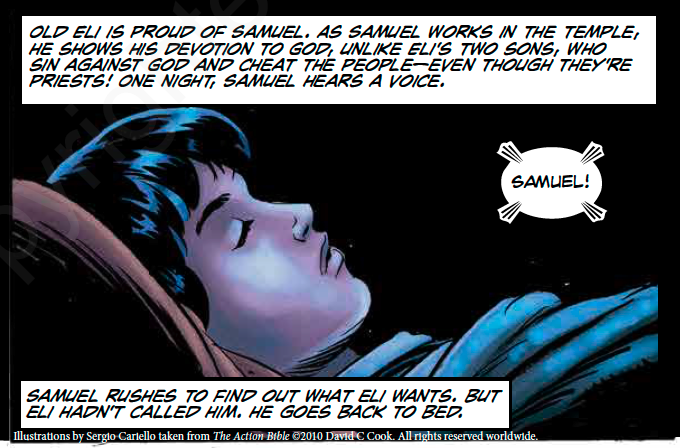
Sit down with the class. Motion to the children as you stand up and sit down. They will stand and sit with you. If they do not, clap a rhythm so they know that they should follow as you stand and sit.
Stand up and read the next Bible verse. When you say, “Went,” start running in place. If the children do not start running in place, clap your rhythm.
Again the LORD called out, “Samuel!” Samuel got up and went to Eli. He said, “Here I am. You called out to me.”
“My son,” Eli said, “I didn’t call you. Go back and lie down.”
1 Samuel 3:6
Motion to the children to sit with you.
Samuel heard someone call out to him a third time. He still did not know who it was.
Stand up and run in place.
He returned to Eli, who told Samuel he had not called him. Eli told Samuel to lie down. Eli told him if he heard the voice again, he should ask the Lord to speak to him.
Sit down and look up.
The Lord came and stood there. He called out, just as he had done the other times. He said, “Samuel! Samuel!”
Then Samuel replied, “Speak. I’m listening.”
1 Samuel 3:10
Optional: If possible, share the images of Samuel from The Action Bible as you teach.

Then God gave Samuel a message about Eli and his family. Samuel told Eli the message.
Show the children what active listening looks like in your community. Active listening may mean making eye contact, nodding your head, or showing interest in some other way. This shows that you are paying attention to what is being said. Have the children repeat your actions.
Children may respond that Samuel did listen because he heard God’s voice. Samuel received the message God wanted him to hear.
Some children may say that Samuel did not listen because he did not know who was speaking to him. God tried many times to get Samuel’s attention.
Samuel did not know who was speaking to him because he did not know who God was or that He wanted to talk to him. Once Eli told Samuel that God was talking to him, Samuel was able to hear what God wanted to say to him.
It was important for Samuel to listen to God’s message for him. Similarly, it is important for us to listen when someone speaks to us. Of course, we want to listen if God speaks, but it is also important for us to listen to other people. When we listen to someone, we let that person know that we value him or her. Listening says that what is being said is important to us.
Here are some tips to help you to be a good listener:
1. Give your full attention to the person speaking. Do not think about your response to what is being said. Just listen.
Listen to this verse:
To answer before listening is foolish and shameful.
Proverbs 18:13
2. Ask questions about what is being said so you understand it.
3. Try to understand what the speaker is feeling about what she is saying. Use clues from the speaker’s body language. For example, if someone is sad and crying, you would not want to smile as you listen to her.
When you listen well to others, you show that you respect and value the speaker and what he is sharing with you.
Let’s play a game to help you all practice listening to others. For this game, you must listen well in order to win.
Place each of the 16 Listening game pictures you prepared before class in different areas of your teaching space. Make sure to show the squares to the children and say out loud the names of the objects in the pictures as you place them around your space. Try to have some room between them if possible. The children will play a human bingo game.
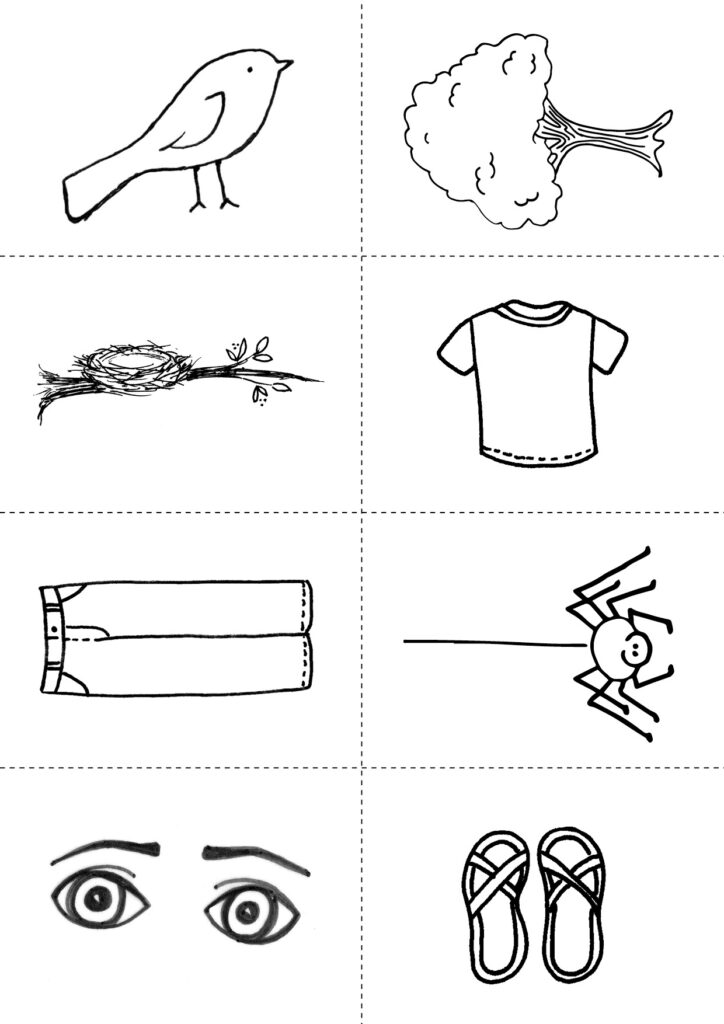
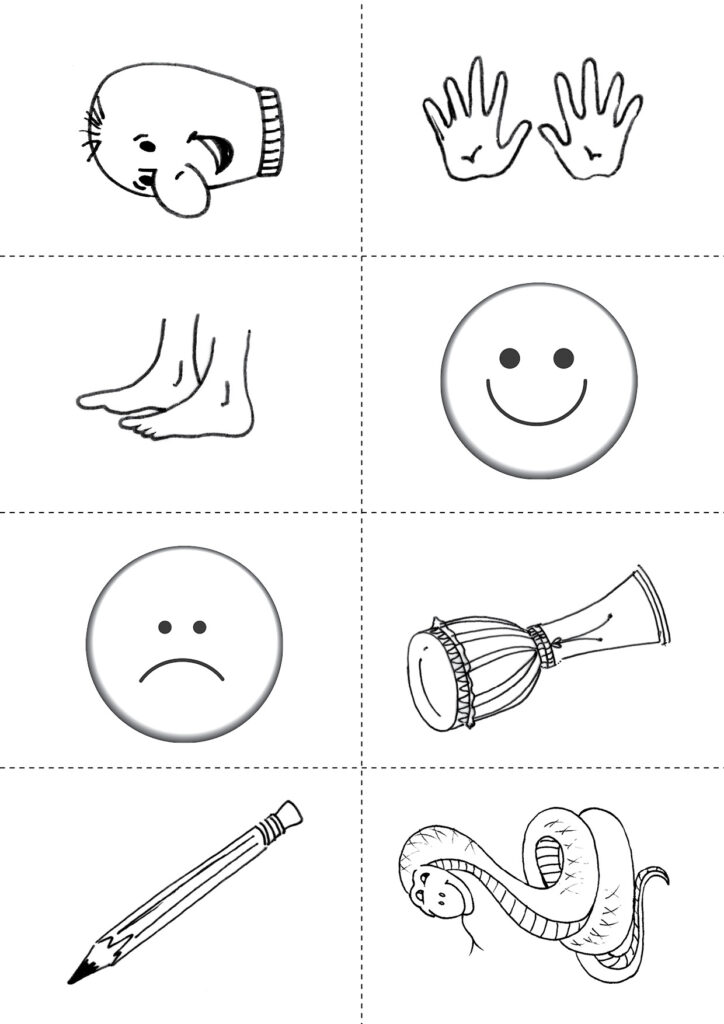
Choose a picture to stand by to start the game. I will call out the words that go along with the pictures. When you hear me call the picture you are standing by, hold up 1 finger and move to another picture. Each time you hear me call a picture you are standing by, hold up another finger. When you are holding 4 fingers up, shout “4 squares!” The first child to hold up 4 fingers and shout, “4 squares!” wins.
Say the following words that are pictured on the squares in any order. If there is not a winner after you have read all of the words, go back and read the words again. Repeat the directions to the children as needed.
bird tree nest shirt
pants spider eyes sandals
nose hands feet happy face
sad face drum pencil snake
Optional:
Give each child a Student Page and 4 pebbles. Have each child choose 4 words on the squares and mark 4 squares with a crayon or coloured pencil.
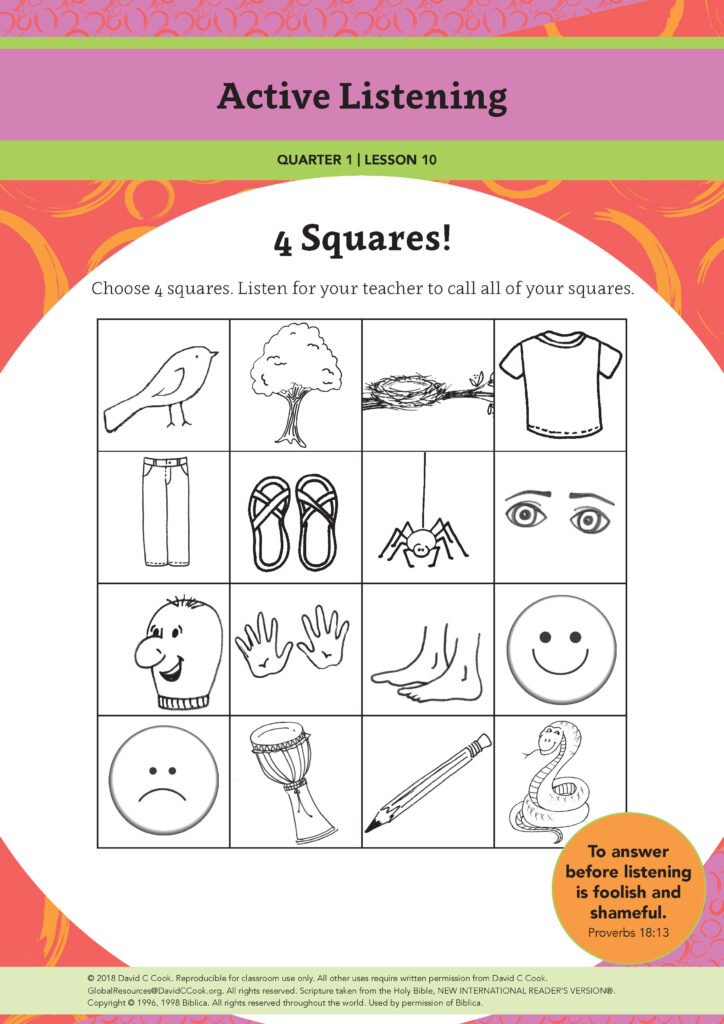
Explain the game to the children. Tell them to listen for the words on the 4 squares they chose. When they hear you say a word on one of their squares, they will place a pebble on that square. The first child who has 4 pebbles placed will say, “4 squares!” That child wins. You can play again if you have time.
The names of the objects are listed above. Read the names of the objects in random order.
Repeat the objects you called out. Ask the children to raise their hands if they heard all 4 of their squares called. Explain to students that if they did not hear you call their squares the first time, they could not win the game. The only way to win the game was to listen carefully. Thank the children for playing the game and listening well.
End of Option
In our game, it was important to listen to what I was saying in order to win.
Allow 2–3 children to answer each of the following questions.
Listening builds friendship. Good friends listen to one another to help them understand each other and share ideas. If you do not listen to your friend and your friend does not listen to you, it will be difficult to stay friends.
Listening can sometimes prevent you from being hurt. When an adult speaks to you, it is important for you to listen to what he says. It is equally important for you to understand what he says. For example, an adult who knows you might tell you to step away from a goat to protect you from being bitten. In this example, the adult wants to protect you.
Think of a time you listened to an adult and you were protected. What happened?
Allow 1–2 children to respond.
Adults and children sometimes say things that will cause problems for you. For example, an adult might ask you to follow her somewhere that is unsafe. It is important to understand what the person tells you and decide whether it is safe to follow her. It is not safe to follow someone you do not know, even if she says she is a friend or knows your family. We will talk more about strangers another time.
Listening helps us share ideas and understand others. The memory verse for today tells us to be careful about how we listen and speak to other people. Listen to our verse again:
Let the words you speak always be full of grace. Learn how to make your words what people want to hear. Then you will know how to answer everyone.
Colossians 4:6
If possible, show the Memory Verse poster. Help the children remember the verse by teaching them actions to go with the following words. Lead children in repeating each sentence with its actions 3 times.
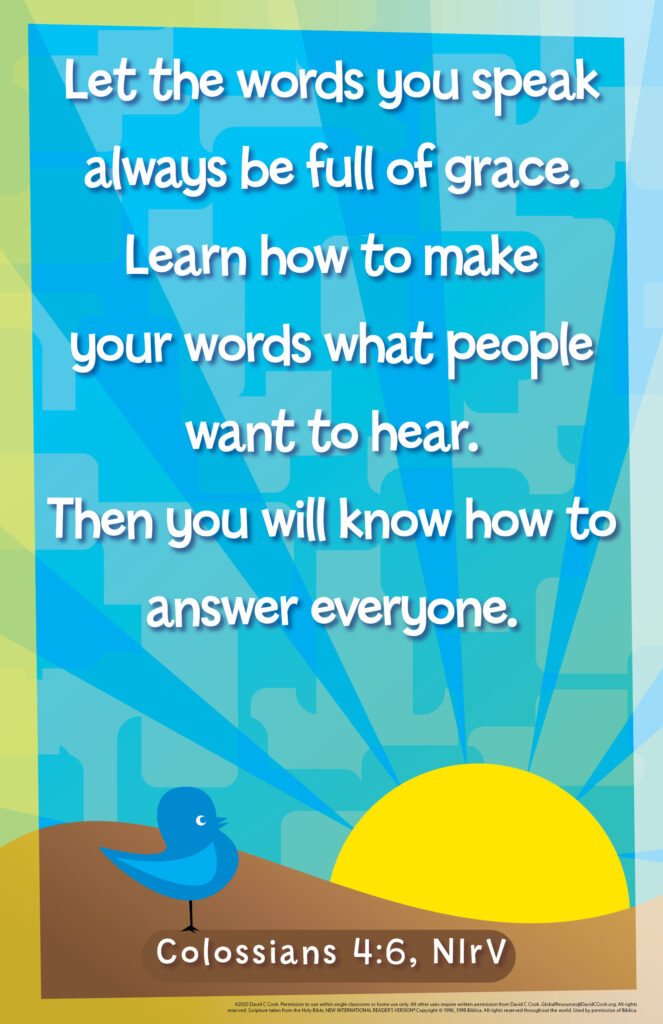
Speak—Put both hands by your mouth and pretend to pull something from it.
Full—Raise your hands in front of you like you are filling something up.
Make—Cup your hands as though an imaginary ball is between them. Rotate the imaginary ball in your hands.
Hear—Pull on 1 ear.
Know—Tap a finger to the side of your forehead.
Everyone—Sweep your arm from side to side to point to everyone.
End class by speaking this blessing, based on 1 Samuel 3, over the children.
Blessing: May God help you to listen and gain wisdom from what you hear. May those around you know that you are listening. May you know that God listens to you and loves you deeply.
If you have time, share this song with your children to celebrate how great God is! Use this as your worship theme this quarter.
Life on Life ©2020 David C Cook. Reproducible for home or classroom use only. All other uses require written permission from David C Cook [email protected]. All rights reserved.